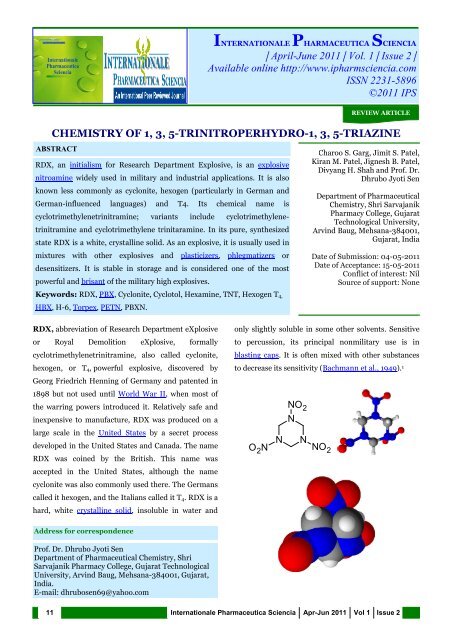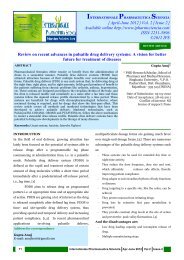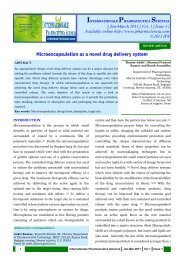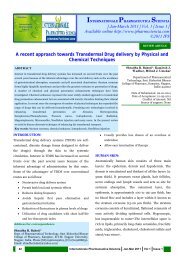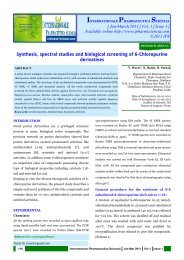chemistry of 1, 3, 5-trinitroperhydro-1, 3, 5-triazine - Internationale ...
chemistry of 1, 3, 5-trinitroperhydro-1, 3, 5-triazine - Internationale ...
chemistry of 1, 3, 5-trinitroperhydro-1, 3, 5-triazine - Internationale ...
You also want an ePaper? Increase the reach of your titles
YUMPU automatically turns print PDFs into web optimized ePapers that Google loves.
CHEMISTRY OF 1, 3, 5-TRINITROPERHYDRO-1, 3, 5-TRIAZINE<br />
ABSTRACT<br />
RDX, an initialism for Research Department Explosive, is an explosive<br />
nitroamine widely used in military and industrial applications. It is also<br />
known less commonly as cyclonite, hexogen (particularly in German and<br />
German-influenced languages) and T4. Its chemical name is<br />
cyclotrimethylenetrinitramine; variants include cyclotrimethylene-<br />
trinitramine and cyclotrimethylene trinitaramine. In its pure, synthesized<br />
state RDX is a white, crystalline solid. As an explosive, it is usually used in<br />
mixtures with other explosives and plasticizers, phlegmatizers or<br />
desensitizers. It is stable in storage and is considered one <strong>of</strong> the most<br />
powerful and brisant <strong>of</strong> the military high explosives.<br />
Keywords: RDX, PBX, Cyclonite, Cyclotol, Hexamine, TNT, Hexogen T4,<br />
HBX, H-6, Torpex, PETN, PBXN.<br />
RDX, abbreviation <strong>of</strong> Research Department eXplosive<br />
or Royal Demolition eXplosive, formally<br />
cyclotrimethylenetrinitramine, also called cyclonite,<br />
hexogen, or T4, powerful explosive, discovered by<br />
Georg Friedrich Henning <strong>of</strong> Germany and patented in<br />
1898 but not used until World War II, when most <strong>of</strong><br />
the warring powers introduced it. Relatively safe and<br />
inexpensive to manufacture, RDX was produced on a<br />
large scale in the United States by a secret process<br />
developed in the United States and Canada. The name<br />
RDX was coined by the British. This name was<br />
accepted in the United States, although the name<br />
cyclonite was also commonly used there. The Germans<br />
called it hexogen, and the Italians called it T4. RDX is a<br />
hard, white crystalline solid, insoluble in water and<br />
Address for correspondence<br />
Pr<strong>of</strong>. Dr. Dhrubo Jyoti Sen<br />
Department <strong>of</strong> Pharmaceutical Chemistry, Shri<br />
Sarvajanik Pharmacy College, Gujarat Technological<br />
University, Arvind Baug, Mehsana-384001, Gujarat,<br />
India.<br />
E-mail: dhrubosen69@yahoo.com<br />
INTERNATIONALE PHARMACEUTICA SCIENCIA<br />
| April-June 2011 | Vol. 1 | Issue 2 |<br />
Available online http://www.ipharmsciencia.com<br />
ISSN 2231-5896<br />
©2011 IPS<br />
only slightly soluble in some other solvents. Sensitive<br />
to percussion, its principal nonmilitary use is in<br />
blasting caps. It is <strong>of</strong>ten mixed with other substances<br />
to decrease its sensitivity (Bachmann et al., 1949). 1<br />
NO 2<br />
N<br />
N N<br />
O2N NO2 REVIEW ARTICLE<br />
Charoo S. Garg, Jimit S. Patel,<br />
Kiran M. Patel, Jignesh B. Patel,<br />
Divyang H. Shah and Pr<strong>of</strong>. Dr.<br />
Dhrubo Jyoti Sen<br />
Department <strong>of</strong> Pharmaceutical<br />
Chemistry, Shri Sarvajanik<br />
Pharmacy College, Gujarat<br />
Technological University,<br />
Arvind Baug, Mehsana-384001,<br />
Gujarat, India<br />
Date <strong>of</strong> Submission: 04-05-2011<br />
Date <strong>of</strong> Acceptance: 15-05-2011<br />
Conflict <strong>of</strong> interest: Nil<br />
Source <strong>of</strong> support: None<br />
11 <strong>Internationale</strong> Pharmaceutica Sciencia Apr-Jun 2011 Vol 1 Issue 2
Chemical name 1,3,5-trinitro-1,3,5-triazinane, 1,3,5-Trinitroperhydro-1,3,5-<strong>triazine</strong>, 1,3,5-Trinitro-1,3,5triazacyclohexane,<br />
1,3,5-Trinitrohexahydro-s-<strong>triazine</strong>, cyclonite, hexogen,<br />
Cyclotrimethylenetrinitramine<br />
Molecular formula C3H6N6O6<br />
Formula Weight 222.11 gm<br />
Molar mass 222.12 g mol −1<br />
Composition C(16.22%) H(2.72%) N(37.84%) O(43.22%)<br />
Molar Refractivity 43.65 ± 0.4 cm 3<br />
Molar Volume 117.0 ± 5.0 cm 3<br />
Parachor 376.0 ± 6.0 cm 3<br />
Index <strong>of</strong> Refraction 1.668 ± 0.03<br />
Surface Tension 106.6 ± 5.0 dyne/cm<br />
Density 1.89 ± 0.1 g/cm 3<br />
Polarizability 17.30 ± 0.5 10 -24 cm 3<br />
Monoisotopic Mass 222.034882 Da<br />
Nominal Mass 222 Da<br />
Average Mass 222.1163 Da<br />
CAS number 121-82-4<br />
PubChem 8490<br />
ChemSpider 8177<br />
UN number 0072, 0391, 0483<br />
Appearance Colorless crystals<br />
Melting point 205.5 °C, 479 K, 402 °F<br />
Boiling point 234 °C, 507 K, 453 °F<br />
Shock sensitivity Low<br />
Friction sensitivity Low<br />
Explosive velocity 8750 m/s<br />
RE factor 1.60<br />
Name<br />
Pr<strong>of</strong>. Dr. Dhrubo Jyoti Sen et al: Chemistry <strong>of</strong> 1, 3, 5-Trinitroperhydro-1, 3, 5-Triazine<br />
RDX is also known, but less commonly, as cyclonite,<br />
hexogen (particularly in German and German-<br />
influenced languages), T4 and chemically as<br />
cyclotrimethylenetrinitramine. Tenney L Davis,<br />
writing in the USA in 1943, stated it was generally<br />
known in the USA as cyclonite; the Germans called it<br />
Hexogen, the Italians T4. In the 1930s, the Royal<br />
Arsenal, Woolwich, started investigating cyclonite as<br />
an explosive to use against German U-boats that were<br />
being built with thicker hulls. Britain wanted an<br />
explosive that was more powerful than TNT. For<br />
security reasons, Britain termed cyclonite as<br />
"Research Department Explosive" (R. D. X.). The term<br />
RDX appeared in the United States in 1946, but the<br />
name RDX is given without explanation. The first<br />
public reference in the United Kingdom to the name<br />
RDX, or R.D.X. to use the <strong>of</strong>ficial title, appeared in<br />
1948; its authors were the Managing Chemist, ROF<br />
Bridgwater, the Chemical Research and Development<br />
Department, Woolwich, and the Director <strong>of</strong> Royal<br />
Ordnance Factories, Explosives; again, it was referred<br />
to as simply RDX (Gilman et al., 1953). 2<br />
Usage<br />
RDX was widely used during World War II, <strong>of</strong>ten in<br />
explosive mixtures with TNT such as Torpex,<br />
Composition B, Cyclotols, and H6. RDX was used in<br />
one <strong>of</strong> the first plastic explosives. RDX is believed to<br />
have been used in many bomb plots including<br />
terrorist plots. The bombs used in the "Dambusters<br />
Raid" contained 6,600 pounds <strong>of</strong> Torpex.<br />
RDX forms the base for a number <strong>of</strong> common military<br />
explosives:<br />
<strong>Internationale</strong> Pharmaceutica Sciencia Apr-Jun 2011 Vol 1 Issue 2<br />
• Composition A: Granular explosive consisting <strong>of</strong><br />
RDX and plasticizing wax. Such as, composition A-<br />
5 (RDX coated with 1.5% stearic acid) and<br />
composition A-3 (91% RDX coated with 9% wax)<br />
12
• Composition B: Castable mixtures <strong>of</strong> RDX and<br />
TNT<br />
• Composition C: The original composition C was<br />
used in World War II, but there have been<br />
subsequent variations including C-2, C-3, and C-4.<br />
C-4 consists <strong>of</strong> RDX (91%), a plasticizer (which can<br />
be dioctyl adipate {DOA}, diethylhexyl, or dioctyl<br />
sebacate) (5.3%), a binder, which is usually<br />
polyisobutylene (2.1%), SAE 10 non-detergent<br />
motor oil (1.6%).<br />
• Composition CH-6: 97.5% RDX, 1.5% calcium<br />
stearate, 0.5% polyisobutylene, and 0.5% graphite.<br />
• Cyclotol: Cyclotol is an explosive consisting <strong>of</strong><br />
castable mixtures <strong>of</strong> RDX and TNT.<br />
It is related to the more common Composition B,<br />
which is roughly 60% RDX and 40% TNT; various<br />
compositions <strong>of</strong> Cyclotol contain from 65% to 80%<br />
RDX. Typical ranges are from 60/40 to 80/20<br />
RDX/TNT, with the most common being 70/30,<br />
while the military mostly uses 77/23 optimized in<br />
warheads. Cyclotol is not commonly used, but was<br />
reportedly the main explosive used in at least some<br />
models <strong>of</strong> US Nuclear weapon. Sublette lists<br />
Cyclotol as the explosive in the US B28 nuclear<br />
bomb and possibly related weapons that used the<br />
common Python primary - W34, W28, W40, and<br />
W49. It was also used in the B53 nuclear bomb and<br />
associated W53 warhead.<br />
• HBX: Castable mixtures <strong>of</strong> RDX, TNT, powdered<br />
aluminium, and D-2 wax with calcium chloride<br />
• H-6: Castable mixture <strong>of</strong> RDX, TNT, powdered<br />
aluminum, and paraffin wax<br />
Pr<strong>of</strong>. Dr. Dhrubo Jyoti Sen et al: Chemistry <strong>of</strong> 1, 3, 5-Trinitroperhydro-1, 3, 5-Triazine<br />
N<br />
N<br />
N<br />
N<br />
1,3,5,7-tetraazatricyclo[3.3.1.1 3,7 ]decane<br />
Hexamine<br />
HNO 3<br />
SCHEME<br />
NO 2<br />
N<br />
• Semtex: (Trade name): Plastic demolition<br />
explosives containing RDX and PETN as major<br />
energetic components<br />
• Torpex: 42% RDX, 40% TNT and 18% powdered<br />
aluminium<br />
• PBX: RDX is also used as a major component <strong>of</strong><br />
many polymer-bonded explosives (PBX). RDX-<br />
based PBX's typically consist <strong>of</strong> RDX and a<br />
polymer/co-polymer binder. Examples <strong>of</strong> RDX-<br />
based PBX formulations include, but are not<br />
limited to: PBX-9007, PBX-9010, PBX-9205, PBX-<br />
9407, PBX-9604, PBXN-106, PBXN-3, PBXN-6,<br />
PBXN-10, PBXN-201, PBX-0280, PBX Type I,<br />
PBXC-116, PBXAF-108, etc.<br />
Outside <strong>of</strong> military applications, RDX is also used in<br />
controlled demolition to raze structures. The<br />
demolition <strong>of</strong> the Jamestown Bridge in the U.S. state<br />
<strong>of</strong> Rhode Island is one example where RDX shaped<br />
charges were used to remove the span (Hale et al.,<br />
1925). 3<br />
Properties<br />
The velocity <strong>of</strong> detonation <strong>of</strong> RDX at a density <strong>of</strong> 1.76<br />
g/cm³ is 8750 m/s.<br />
It is a colourless solid, <strong>of</strong> maximum theoretical<br />
density 1.82 g/cm³. It is obtained by reacting<br />
concentrated nitric acid with hexamine (Luo et al.,<br />
2002). 4<br />
N N<br />
O2N NO2 1,3,5-trinitro-1,3,5-triazinane<br />
RDX<br />
(CH2)6N4 + 10HNO3 → (CH2-N-NO2)3 +<br />
3CH2(ONO2)2 + NH4NO3 + 3H2O<br />
ONO 2<br />
ONO 2<br />
+<br />
+ NH 4 NO 3 H 2 O<br />
methylene dinitrate<br />
13 <strong>Internationale</strong> Pharmaceutica Sciencia Apr-Jun 2011 Vol 1 Issue 2<br />
+
It is a heterocycle and has the molecular shape <strong>of</strong> a<br />
ring. It starts to decompose at about 170°C and melts<br />
at 204°C. Its structural formula is: hexahydro-1,3,5-<br />
trinitro-1,3,5-<strong>triazine</strong> or (CH2-N-NO2)3.<br />
At room temperature, it is very stable. It burns rather<br />
than explodes and detonates only with a detonator,<br />
being unaffected even by small arms fire. It is less<br />
sensitive than pentaerythritol tetranitrate (PETN).<br />
However, it is very sensitive when crystallized, below<br />
−4°C. Under normal conditions, RDX has a figure <strong>of</strong><br />
insensitivity <strong>of</strong> exactly 80 (RDX defines the reference<br />
point.).<br />
RDX sublimes in vacuum, which limits its use in<br />
pyrotechnic fasteners for spacecraft.<br />
RDX when exploded in air has about 1.5 times the<br />
explosive power <strong>of</strong> TNT per unit weight and about 2.0<br />
times per unit volume.<br />
History<br />
RDX was used by both sides in World War II. The U.S.<br />
produced about 15,000 long tons (15,000 t) per<br />
month during WW II and Germany about 7,000 long<br />
tons (7,100 t) per month. RDX had the major<br />
advantages <strong>of</strong> possessing greater explosive power than<br />
TNT used in the First World War, and requiring no<br />
additional raw materials for its manufacture<br />
(Simmons et al., 1948). 5,6<br />
Germany<br />
Pr<strong>of</strong>. Dr. Dhrubo Jyoti Sen et al: Chemistry <strong>of</strong> 1, 3, 5-Trinitroperhydro-1, 3, 5-Triazine<br />
The discovery <strong>of</strong> RDX dates from 1898 when Georg<br />
Friedrich Henning obtained a German patent (patent<br />
No. 104280) for its manufacture, by nitrating<br />
hexamine nitrate (hexamethylenetetramine nitrate)<br />
with concentrated nitric acid. In this 1898 patent, its<br />
properties as a medical compound were mentioned;<br />
however, three further German patents obtained by<br />
Henning in 1916 proposed its use in smokeless<br />
propellants. The German military started<br />
investigating its use in 1920 and referred to it as<br />
hexogen. Research and development findings were<br />
not published further until Edmund von Herz,<br />
described as an Austrian and later a German citizen,<br />
obtained a British patent in 1921 and a U.S. patent in<br />
1922. Both patent claims were initiated in Austria;<br />
and described the manufacture <strong>of</strong> RDX by nitrating<br />
hexamethylenetetramine. The British patent claims<br />
included the manufacture <strong>of</strong> RDX by nitration, its use<br />
with or without other explosives, and its use as a<br />
bursting charge and as a initiator. The U.S. patent<br />
claim was for the use <strong>of</strong> a hollow explosive device<br />
containing RDX and a detonator cap containing RDX.<br />
In the 1930s, Germany developed improved<br />
production methods.<br />
During the Second World War, Germany used the<br />
code names W Salt, SH Salt, K-method, the E-method<br />
and the KA-method. These represented the names <strong>of</strong><br />
the developers <strong>of</strong> the various chemical processes used<br />
to prepare RDX. The W-method was developed by<br />
Wolfram in 1934 and gave RDX the code name "W-<br />
Salz". It used sulphamic acid, formaldehyde and nitric<br />
acid. SH-Salz (SH salt) was from Schnurr who<br />
developed a batch-process in 1937–38 based on<br />
nitrating hexamine. The K-method was from Knõffler<br />
and was based on adding ammonium nitrate to the<br />
hexamine / nitric acid process The E-method was<br />
developed by Ebele, in Germany, and turned out to be<br />
identical to the Ross and Schiessler process described<br />
later. The KA-method was developed by Knöffler, in<br />
Germany, and turned out to be identical to the<br />
Bachmann process described later.<br />
UK<br />
<strong>Internationale</strong> Pharmaceutica Sciencia Apr-Jun 2011 Vol 1 Issue 2<br />
In the United Kingdom (UK), RDX was manufactured<br />
from 1933 by the Research Department in a pilot<br />
plant at the Royal Arsenal in Woolwich, London; a<br />
larger pilot plant being built at the RGPF Waltham<br />
Abbey just outside London in 1939. In 1939 a twin-<br />
unit industrial-scale plant was designed to be installed<br />
at a new 700 acres (280 ha) site, ROF Bridgwater,<br />
away from London; and production <strong>of</strong> RDX started at<br />
Bridgwater on one unit in August 1941. The ROF<br />
Bridgwater plant brought in ammonia and methanol<br />
as raw materials: the methanol was converted to<br />
formaldehyde and some <strong>of</strong> the ammonia converted to<br />
nitric acid, which was concentrated for RDX<br />
production (Simmons et al., 1948). 5,6 The rest <strong>of</strong> the<br />
ammonia was reacted with formaldehyde to produce<br />
hexamine. The hexamine plant was supplied by<br />
14
Imperial Chemical Industries; and it incorporated<br />
some features based on data obtained from the United<br />
States (U.S.) (Simmons et al., 1948). 5,6 RDX was<br />
produced by continually adding hexamine and<br />
concentrated nitric acid to a cooled mixture <strong>of</strong><br />
hexamine and nitric acid in the nitrator (Simmons et<br />
al., 1948). 5,6 The RDX was purified and processed for<br />
its intended use; and recovery and reuse <strong>of</strong> some<br />
methanol and nitric acid was also carried out. The<br />
hexamine-nitration and RDX purification plants were<br />
duplicated (i.e. twin-unit) to provide some insurance<br />
against loss <strong>of</strong> production due to fire, explosion or air<br />
attack.<br />
The United Kingdom and British Empire were<br />
fighting without allies against Nazi Germany until the<br />
middle <strong>of</strong> 1941 and had to be self-sufficient. At that<br />
time (1941), the UK had the capacity to produce<br />
70 long tons (71 t) (160,000 lb) <strong>of</strong> RDX per week;<br />
both Canada, an allied country and former self-<br />
governing dominion <strong>of</strong> the British Empire, and the<br />
U.S. were looked upon to supply ammunition and<br />
explosives, including RDX. By 1942 the Royal Air<br />
Force's annual requirement was forecast to be<br />
52,000 long tons (53,000 t) <strong>of</strong> RDX, much <strong>of</strong> which<br />
came from North America (Canada and the U.S.).<br />
Canada<br />
A different method <strong>of</strong> production to the Woolwich<br />
process was found and used in Canada, possibly at the<br />
McGill University Department <strong>of</strong> Chemistry. This was<br />
based on reacting paraformaldehyde and ammonium<br />
nitrate in acetic anhydride. A UK patent application<br />
was made by Robert Walter Schiessler, Pennsylvania<br />
State College and James Hamilton Ross, at McGill,<br />
Canada, in May 1942 and the UK patent was issued in<br />
December 1947. Gilman states that the same method<br />
<strong>of</strong> production had been independently discovered by<br />
Ebele in Germany prior to Schiessler and Ross, but<br />
that this was not known by the Allies. Urbański<br />
provides details <strong>of</strong> five methods <strong>of</strong> production: this is<br />
listed as the (German) E-method.<br />
Pr<strong>of</strong>. Dr. Dhrubo Jyoti Sen et al: Chemistry <strong>of</strong> 1, 3, 5-Trinitroperhydro-1, 3, 5-Triazine<br />
UK, U.S. and Canadian production and<br />
development<br />
At the beginning <strong>of</strong> the 1940s, the major U.S.<br />
explosive manufacturers, E. I. du Pont de Nemours &<br />
Company and Hercules had several decades <strong>of</strong><br />
experience <strong>of</strong> manufacturing Trinitrotoluene (TNT)<br />
and had no wish to experiment with new explosives; a<br />
view also held by the U.S. Army Ordnance, who<br />
proposed to continue using TNT. RDX had been<br />
tested by Picatinny Arsenal in 1929 and it was<br />
regarded as too expensive and too sensitive. The Navy<br />
proposed to continue using ammonium picrate. In<br />
contrast, the view that new explosives were<br />
unnecessary was not shared by the National Defense<br />
Research Committee (NDRC), who had visited The<br />
Royal Arsenal, Woolwich. James B. Conant, chairman<br />
<strong>of</strong> Division B, wished to involve academic research<br />
into this area. Conant therefore set up an<br />
Experimental Explosives Research Laboratory at the<br />
Bureau <strong>of</strong> Mines, Bruceton, Pennsylvania using direct<br />
Office <strong>of</strong> Scientific Research and Development<br />
(OSRD) funding.<br />
In 1941, the UK's Tizard Mission visited the U.S. Army<br />
and Navy departments and part <strong>of</strong> the information<br />
handed over included details <strong>of</strong> the "Woolwich"<br />
method <strong>of</strong> manufacture <strong>of</strong> RDX and its stabilisation<br />
by mixing it with beeswax. The UK was asking that the<br />
U.S. and Canada, combined, supply 220 short tons<br />
(200 t) (440,000 lb) <strong>of</strong> RDX per day. A decision was<br />
taken by William H. P. Blandy, Chief <strong>of</strong> the Bureau <strong>of</strong><br />
Ordnance to adopt RDX for use in mines and<br />
torpedoes. Given the immediate need for RDX, the<br />
U.S. Army Ordnance, at Blandy's request, built a plant<br />
that just copied the equipment and process used at<br />
Woolwich. The result was the Wabash River<br />
Ordinance Works run by E. I. du Pont de Nemours &<br />
Company. This works had the largest nitric acid plant<br />
in the world, at that time. The Woolwich process was<br />
expensive; it needed 11 pounds <strong>of</strong> strong nitric acid for<br />
every pound <strong>of</strong> RDX.<br />
By early 1941, the NDRC was researching new<br />
processes. The Woolwich or direct nitration process<br />
has at least two serious disadvantages: (1) it used large<br />
amounts <strong>of</strong> nitric acid and (2) at least one-half <strong>of</strong> the<br />
15 <strong>Internationale</strong> Pharmaceutica Sciencia Apr-Jun 2011 Vol 1 Issue 2
formaldehyde is lost. One mole <strong>of</strong><br />
hexamethylenetetramine could produce at most one<br />
mole <strong>of</strong> RDX. At least three laboratories with no<br />
previous explosive experience were tasked to develop<br />
better production methods for RDX; they were based<br />
at Cornell, Michigan and Penn State universities.<br />
Werner Emmanuel Bachmann, from Michigan,<br />
successfully developed the "combination process" by<br />
combining the Canadian process with direct nitration.<br />
The combination process required large quantities <strong>of</strong><br />
acetic anhydride instead <strong>of</strong> nitric acid in the old<br />
British "Woolwich process". Ideally, the combination<br />
process could produce two moles <strong>of</strong> RDX from each<br />
mole <strong>of</strong> hexamethylenetetramine.<br />
Vast increases in production <strong>of</strong> RDX could not<br />
continue to rely on the use <strong>of</strong> the beeswax, first used<br />
in the Woolwich process, to desensitize the RDX. A<br />
substitute based on petroleum was developed at the<br />
Bruceton Explosives Research Laboratory (Gilman et<br />
al., 1953). 2<br />
Bachmann process<br />
Pr<strong>of</strong>. Dr. Dhrubo Jyoti Sen et al: Chemistry <strong>of</strong> 1, 3, 5-Trinitroperhydro-1, 3, 5-Triazine<br />
The NDRC tasked three companies to develop pilot<br />
plants. They were the Western Cartridge Company, E.<br />
I. du Pont de Nemours & Company and Tennessee<br />
Eastman Company, part <strong>of</strong> Eastman Kodak. The<br />
Eastman Chemical Company (TEC), Kingsport,<br />
Tennessee, a leading manufacturer <strong>of</strong> acetic<br />
anhydride, Werner Emmanuel Bachmann successfully<br />
developed a continuous-flow manufacturing process<br />
for RDX. RDX was crucial to the war effort and the<br />
current batch-production process could not keep up.<br />
In February 1942, TEC built the Wexler Bend pilot<br />
plant and began producing small amounts <strong>of</strong> RDX<br />
(Bachmann et al., 1949). 1 This led to the U.S.<br />
government authorizing TEC to design and build<br />
Holston Ordnance Works (H.O.W.) in June 1942. By<br />
April 1943, RDX was being manufactured there. At<br />
the end <strong>of</strong> 1944, the Holston plant and the Wabash<br />
River Ordinance Works (which used the Woolwich<br />
process) were making 25,000 short tons (23,000 t)<br />
(50 million pounds) <strong>of</strong> Composition B per month. The<br />
U.S. Bachmann process for RDX was found to be<br />
richer in HMX than the United Kingdom's RDX. This<br />
later led to a RDX plant using the Bachmann process<br />
being set up at ROF Bridgwater in 1955, to produce<br />
both RDX and HMX (Luo et al., 2002). 4<br />
Military compositions<br />
The United Kingdom's intention in World War II was<br />
to use "desensitised" RDX: in the original Woolwich<br />
process RDX coated with beeswax, but changed to a<br />
RDX coated with petroleum-based product, based on<br />
the work carried out at Bruceton. In the event the UK<br />
was unable to obtain sufficient RDX to meet its needs.<br />
Some <strong>of</strong> this shortfall was met by substituting a<br />
mixture <strong>of</strong> ammonium nitrate and TNT. Karl Dönitz<br />
was reputed to have claimed that "an aircraft can no<br />
more kill a U-boat than a crow can kill a mole".<br />
However, by May 1942 Wellington bombers began to<br />
deploy depth charges containing Torpex, a mixture <strong>of</strong><br />
RDX, TNT and aluminium, which had up to 50 per<br />
cent more destructive power than TNT-filled depth<br />
charges. Considerable quantities <strong>of</strong> the RDX–TNT<br />
mixture were produced at the Holston Ordnance<br />
Works, with Tennessee Eastman developing an<br />
automated mixing and cooling process based around<br />
the use <strong>of</strong> stainless steel conveyor belts.<br />
Terrorism<br />
Ahmed Ressam, the al-Qaeda Millenium Bomber,<br />
used a small quantity <strong>of</strong> RDX as one <strong>of</strong> the<br />
components in the explosives that he prepared to<br />
bomb Los Angeles International Airport on New<br />
Year's Eve 1999/2000; the combined explosives could<br />
have produced a blast forty times greater than that <strong>of</strong><br />
a devastating car bomb. RDX was main component<br />
used for the 2006 Mumbai train bombings. It was also<br />
believed to be the explosive in the 2010 Moscow<br />
Metro bombings.<br />
Conclusion<br />
<strong>Internationale</strong> Pharmaceutica Sciencia Apr-Jun 2011 Vol 1 Issue 2<br />
Trinitro derivative <strong>of</strong> reduced <strong>triazine</strong> ring is a small<br />
molecule but has tremendous explosive property.<br />
Urotropine is hexamethylene tetramine which is<br />
obtained by bubbling <strong>of</strong> air through the mixture <strong>of</strong><br />
formalin and ammonium hydroxide. This urotropine<br />
is active as urinary tract infection but when it is<br />
16
treated with nitric acid, it gets nitrated to form RDX<br />
and methylene dinitrate which has remarkable<br />
explosive property. The explosive property is approx<br />
9km/sec!<br />
References:<br />
1) Bachmann WE., Sheehan JC. A New Method <strong>of</strong><br />
Preparing the High Explosive RDX, Journal <strong>of</strong> the<br />
American Chemical Society 1949; 71(5): 1842–1845.<br />
2) Gilman H. The Chemistry <strong>of</strong> Explosives, Organic<br />
Chemistry an Advanced Treatise, III, Wiley;<br />
Chapman & Hall, 1953; 985–986.<br />
3) Hale GC. The Nitration <strong>of</strong> Hexamethylenetetramine,<br />
Journal <strong>of</strong> the American Chemical Society 1925;<br />
47(11): 2754–2763.<br />
Pr<strong>of</strong>. Dr. Dhrubo Jyoti Sen et al: Chemistry <strong>of</strong> 1, 3, 5-Trinitroperhydro-1, 3, 5-Triazine<br />
4) Luo KM, Lin SH, Chang JG, Huang TH. Evaluations<br />
<strong>of</strong> kinetic parameters and critical runaway<br />
conditions in the reaction system <strong>of</strong> hexamine-nitric<br />
acid to produce RDX in a non-isothermal batch<br />
reactor, Journal <strong>of</strong> Loss Prevention in the Process<br />
Industries 2002; 15(2): 119–127.<br />
5) Simmons WH, Forster A, Bowden RC. The<br />
Manufacture <strong>of</strong> R.D.X. in Great Britain: Part II –<br />
Raw Materials and Ancillary Processes, The<br />
Industrial Chemist 1948; 24: 530–545.<br />
6) Simmons WH, Forster A, Bowden R. (September<br />
1948), The Manufacture <strong>of</strong> R.D.X. in Great Britain:<br />
Part III – Production <strong>of</strong> the Explosive, The Industrial<br />
Chemist 1948; 24: 593–601.<br />
17 <strong>Internationale</strong> Pharmaceutica Sciencia Apr-Jun 2011 Vol 1 Issue 2


